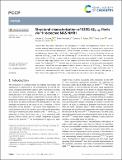| dc.contributor.author | Golota, Natalie C. | |
| dc.contributor.author | Michael, Brian | |
| dc.contributor.author | Saliba, Edward P. | |
| dc.contributor.author | Linse, Sara | |
| dc.contributor.author | Griffin, Robert G. | |
| dc.date.accessioned | 2024-09-12T20:37:33Z | |
| dc.date.available | 2024-09-12T20:37:33Z | |
| dc.date.issued | 2024-05-08 | |
| dc.identifier.issn | 1463-9084 | |
| dc.identifier.uri | https://hdl.handle.net/1721.1/156718 | |
| dc.description.abstract | Amyloid fibrils have been implicated in the pathogenesis of several neurodegenerative diseases, the most prevalent example being Alzheimer's disease (AD). Despite the prevalence of AD, relatively little is known about the structure of the associated amyloid fibrils. This has motivated our studies of fibril structures, extended here to the familial Arctic mutant of Aβ1–42, E22G-Aβ1–42. We found E22G-AβM0,1–42 is toxic to Escherichia coli, thus we expressed E22G-Aβ1–42 fused to the self-cleavable tag NPro in the form of its EDDIE mutant. Since the high surface activity of E22G-Aβ1–42 makes it difficult to obtain more than sparse quantities of fibrils, we employed 1H detected magic angle spinning (MAS) nuclear magnetic resonance (NMR) experiments to characterize the protein. The 1H detected 13C–13C methods were first validated by application to fully protonated amyloidogenic nanocrystals of GNNQQNY, and then applied to fibrils of the Arctic mutant of Aβ, E22G-Aβ1–42. The MAS NMR spectra indicate that the biosynthetic samples of E22G-Aβ1–42 fibrils comprise a single conformation with 13C chemical shifts extracted from hCH, hNH, and hCCH spectra that are very similar to those of wild type Aβ1–42 fibrils. These results suggest that E22G-Aβ1–42 fibrils have a structure similar to that of wild type Aβ1–42. | en_US |
| dc.publisher | Royal Society of Chemistry | en_US |
| dc.relation.isversionof | https://doi.org/10.1039/D4CP00553H | en_US |
| dc.rights | Creative Commons Attribution | en_US |
| dc.rights.uri | https://creativecommons.org/licenses/by/3.0/ | en_US |
| dc.source | Royal Society of Chemistry | en_US |
| dc.title | Structural Characterization of E22G Aβ1-42 Fibrils via 1H detected MAS NMR | en_US |
| dc.type | Article | en_US |
| dc.identifier.citation | Phys. Chem. Chem. Phys., 2024, 26, 14664-14674 | en_US |
| dc.contributor.department | Massachusetts Institute of Technology. Department of Chemistry | en_US |
| dc.contributor.department | Francis Bitter Magnet Laboratory (Massachusetts Institute of Technology) | en_US |
| dc.relation.journal | Physical Chemistry Chemical Physics | en_US |
| dc.eprint.version | Final published version | en_US |
| dc.type.uri | http://purl.org/eprint/type/JournalArticle | en_US |
| eprint.status | http://purl.org/eprint/status/PeerReviewed | en_US |
| dspace.date.submission | 2024-09-06T15:48:11Z | |
| mit.journal.volume | 26 | en_US |
| mit.license | PUBLISHER_CC | |
| mit.metadata.status | Authority Work and Publication Information Needed | en_US |
